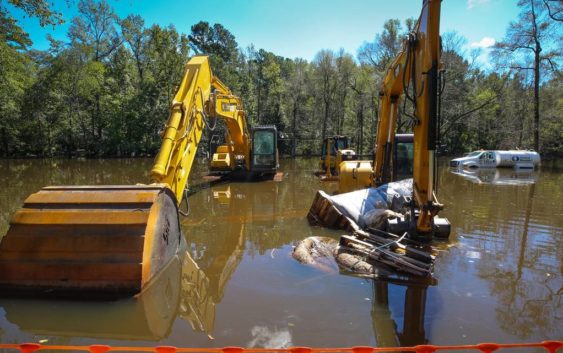- The Texanist: Texas Gets More Tornadoes Than Any Other State, but Don’t Freak Out
- U.S. Supreme Court says Texans can sue state for flood damage
- This is how many hurricanes NC State researchers predict this year
- NC State researchers predict above-average hurricane season
- Supreme Court rules in favor of property owners suing Texas over flood damage
Did hurricane-driven flood poison Cheraw neighborhood? Feds investigating

Mud-spattered and exhausted from cleaning up after the flood, Barbara Bullard-Mimms scowled as she thought about the brown, sediment-filled water that poured into her house last weekend.
Swirling in the flood water were toxins powerful enough to make her sick, she said Wednesday while surveying the mucky mess in her neighborhood.
“I’m extremely concerned about the contaminants,’’ Bullard-Mimms said. “I’m more concerned about that than the flooding. I can recover from the flooding. … But you don’t know what made it in your house.’’
Bullard-Mimms is worried because she lives across the street from a federal Superfund cleanup site in Cheraw that flooded last weekend during Hurricane Florence, potentially spreading contamination to other land and creeks in the area.
The site, undergoing a federal cleanup effort because it is so polluted, rests in a densely populated neighborhood downhill from a fabric plant that federal regulators say polluted the area decades ago. High levels of cancer-causing PCBs and toxic metals have been found in creek mud and the yards of nearby homes.
Part of the Superfund cleanup site also contains a now-closed public park, where children once played on swings and waded in Huckleberry Creek. During the past two years, regulators discovered toxins in the creek’s mud and notified the public, federal documents show.
On Tuesday, flood water stood thigh deep in Huckleberry Park. Water reached the cab of a federal contractor’s tanker truck and halfway up the treads of excavation equipment that were being used in the cleanup.
Lying on its side was a port-a-john. Pushed up against the guard rail of a road 20 yards away lay a container like those used to store contaminated soil excavated from the property. The stench of oil filled the air, and a sheen of a gasoline-like substance was visible in puddles.
“The whole town should be concerned about this,’’ said Bullard-Mimms, a 56-year-old former social worker.
Efforts this week to reach a U.S. Environmental Protection official about the Cheraw site and the flood were unsuccessful. But, on its website, the agency said it does not think there is a “significant likelihood of hazardous substance release or damage due to the storm’’ from the site.
Still, the EPA plans to send inspectors to the Carolinas this week to see how many Superfund sites were flooded and whether there is anything to be concerned about. The Carolinas have about two dozen Superfund sites that were in the path of Florence, including the Cheraw site and five others in South Carolina.
Bullard-Mimms said there is too much pollution from the Cheraw site to think the flood didn’t spread pollution.
EPA records show the site was being cleaned up before the storm because it contains harmful industrial contaminants, including mercury, lead and PCBs, a class of industrial toxins powerful enough to cause cancer in people.
The pollution came from the Burlington Industries textile factory on S.C. 9, records show. A drainage ditch that ran off the site dispersed the pollution into three creeks and the Great Pee Dee River after the plant opened in 1961, according to EPA records reviewed by The State.
For years, the extent of the pollution apparently was unknown to the public.
Occasional complaints, some dating to 1970, drew visits from state regulators. In one case, a complaint about green sludge draining off the plant site was registered.
Only in the past two years has the severity of the contamination been discovered, when tests showed high levels of industrial toxins in soil downstream from the plant, according to EPA documents. State regulators also have issued warnings urging people to limit their consumption of fish from the nearby Great Pee Dee River because of PCB contamination, like that on the Burlington site.
Earlier this year, the EPA added the Burlington property and adjacent land to its Superfund cleanup list, which includes some of the nation’s most polluted sites in need of cleanup. South Carolina has about 25 sites on the national Superfund priorities list.
Not everyone in Cheraw is as concerned about the pollution as Bullard-Mimms.
Laurie and Kyle Morrell, whose two children played at the Huckleberry Park almost every day when they were growing up, think the EPA had cleaned up most of the worst contamination before Florence washed over it. That work included scraping the top few feet of soil away from the site and hauling it off, they said.
“They had dug out all of the contaminated soil – or so they said,’’ Kyle Morrell said.
Russell Roscoe, who moved next door to the Morrells last spring, said he didn’t know much about the contaminated land until recently.
But like Bullard-Mimms, Roscoe said the sediment that washed into his house probably contained some of the industrial pollution that has plagued the area.
‘Inside the house is full of mud,’’ he said. “I would imagine (contaminants) are in there if mud came out of the creek.’’